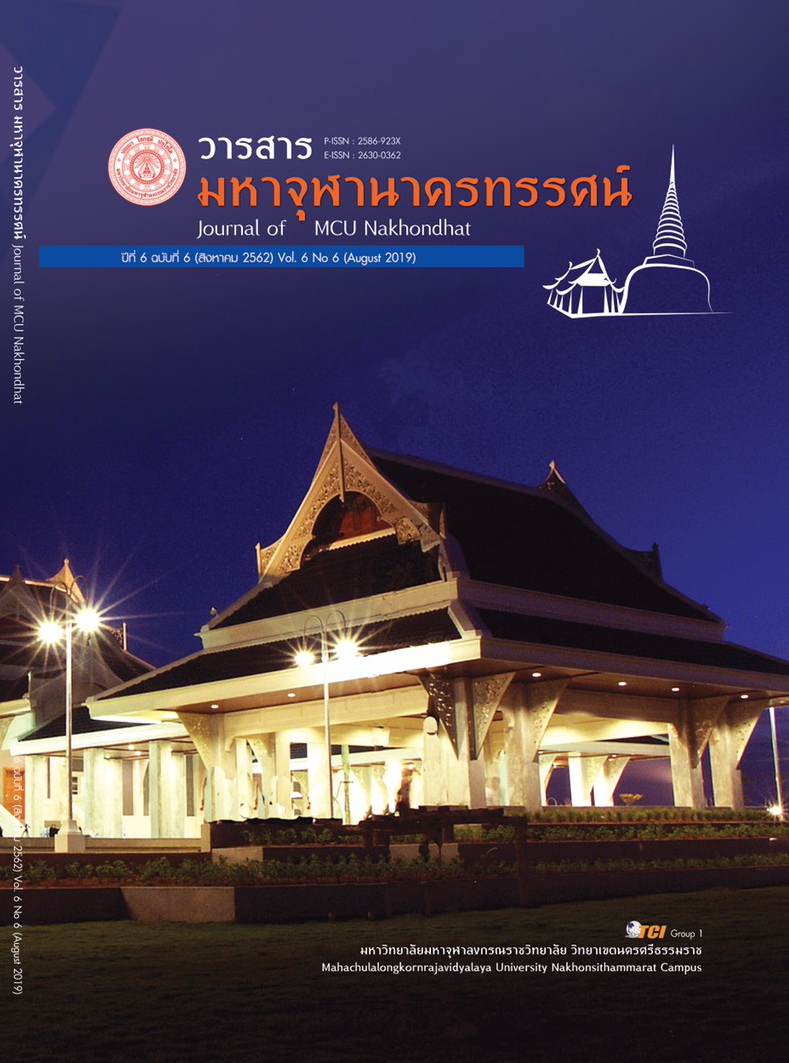THE APPLICATION GUIDELINE OF GRATEFULNESS IN THE PRESENT THAI SOCIETY
Main Article Content
Abstract
The study entitled 'The Guideline for the Application of Gratefulness in the Present Thai Society' aimed 1) to study the current problems of Thai society, 2) to study the principles of gratitude in line with the Buddhist scriptures. The study was conducted by the qualitative research methodology, focusing on documentary research with the presentation of descriptive data.
The findings were as follows:
- The Current problems of Thai society Thai society is a society with Buddhism as an anchor for the mind. Live according to the teachings of Buddhism Thai society is therefore a society that the world has praised A society that is pleasant, generous, beautiful, smiling face but now the status of Siam City is smiling. Began to fade somewhat Relying on many factors such as economy, politics or people's habits Began to distance himself from the path of Buddhism Life is lacking in the mind. Until becoming a problem for Thai society.
- The Gratitude principles along the lines that appear in the Buddhist scriptures. The researchers found that Thai society praised those who are grateful. Is one virtue That can measure the goodness of a person Because it is a form of good behavior This gratitude is the basis of good people. When good people are grateful as a foundation All good virtue flows to include those good people.
3. The Guidelines for the application of gratitude in the present Thai society. Thai society should follow the teachings of the Lord Buddha very much. Thai people should repay or show gratitude to the Lord Buddha for good behavior, physically, verbally and mentally in a moral framework. Good ethics Not causing trouble for oneself and others The Lord Buddha hoped that the animals of the world would be kind to one another, to establish oneself as good people.
Article Details
References
พระเทพญาณวิศิษย์ (ชัยทวี คุตฺตจิตฺโต). (2555). มงคล 38 ประการ ทางก้าวหน้าของชีวิต. กรุงเทพมหานคร: ธรรมสภา.
พระเทพวิสุทธิเมธี (ปัญญานันทภิกขุ). (2536). กตัญญูกตเวที เป็นเครื่องหมายของคนดี. กรุงเทพมหานคร: ธรรมสภา.
พระธรรมกิตติวงศ์ (ทองดี สุรเตโช). (2541). พระในบ้าน. กรุงเทพมหานคร: รุ่งเรืองสาส์นการพิมพ์.
พระธรรมโกศาจารย์ (พุทธทาสภิกขุ). (2536). กตัญญูกตเวที เป็นร่มโพธิ์ร่มไทรของโลก. กรุงเทพมหานคร: ธรรมสภา.
พระธรรมธีรราชมหามุนี (โชดก ญาณสิทธิ). (2536). มงคล 38 (พิมพ์ครั้งที่ 7). กรุงเทพมหานคร: การพิมพ์พระนคร.
พระธรรมปิฎก (ป.อ. ปยุตฺโต). (2541). ทางสายอิสรภาพของการศึกษาไทย (พิมพ์ครั้งที่ 2). กรุงเทพมหานคร: มูลนิธิพุทธธรรม.
พระพรหมคุณาภรณ์ (ป.อ.ปยุตฺโต). (2550). คุณบิดามารดาสุดพรรณนามหาศาล (พิมพ์ครั้งที่ 14). กรุงเทพมหานคร: บริษัท พิมพ์สวย จากัด.
พระอัครวินท์ อภิชาโต (หิรัณยาภาพงศ์). (2559). วิธีการประยุกต์ใช้คำสอนเรื่องกตัญญูกตเวทีกับวัยรุ่นในสังคมไทยปัจจุบัน. ใน พุทธศาสตรมหาบัณฑิต สาขาวิชาพระพุทธศาสนา. มหาวิทยาลัยมหาจุฬาลงกรณราชวิทยาลัย.
มหาจุฬาลงกรณราชวิทยาลัย. (2539). พระไตรปิฎกภาษาไทย ฉบับมหาจุฬาลงกรณราชวิทยาลัย. กรุงเทพมหานคร: โรงพิมพ์มหาจุฬาลงกรณราชวิทยาลัย.
สมเด็จพระมหาวีรวงศ์ (พิมพ์ ธมฺมธโร). (2546). มงคลยอดชีวิต ฉบับสมบูรณ์. กรุงเทพมหานคร: ธรรมสภา.


